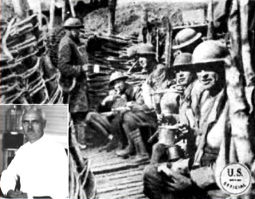16-22 December 1917
Reforming the Military Supply System
The U.S. Army’s system of supply at the start of World War I was much in need of reform. There was little coordination. Decentralized record-keeping and open competition brought about scarcity and high prices. Ports of embarkation along the east coast suffered intense congestion. And the system overall smacked of poor management and lack of accountability.
 “When a division quartermaster [in Europe] opened a box of men’s underwear, he was shocked to discover twelve dozen infants’ nightshirts! In a consignment of rubber boots he found ladies or misses sizes — and small sizes at that. Engineers arrived without tools, wagons without wheels, trucks without motors, mules without harnesses.”
“When a division quartermaster [in Europe] opened a box of men’s underwear, he was shocked to discover twelve dozen infants’ nightshirts! In a consignment of rubber boots he found ladies or misses sizes — and small sizes at that. Engineers arrived without tools, wagons without wheels, trucks without motors, mules without harnesses.”
On 19 December 1917, Secretary of War Newton Baker picked Major General George W. Goethals to serve as Acting Quartermaster General, and charged him with the Herculean task of reforming the entire military supply system.
Goethals, who a decade earlier had overseen construction of the Panama Canal, instantly set about “functionalizing” the Army supply system, introduced centralized procurement, vertically-integrated control, and other modern business practices.
He instituted a more rational direction of supply and led the way for more far-reaching reforms in WWII and beyond.
Compiled by Dr. Steven Anders, former Quartermaster School historian.
Quote of the Week:
America has joined forces with the allied powers, and what we have of blood and treasure are yours. Therefore, it is with loving pride that we drape the colors in tribute of respect to this citizen of your great Republic, and here and now, in the shadow of the illustrious dead, we pledge our heart and our honor in carrying this war to a successful issue.— Colonel Charles E. Stanton,
La Fayette, we are here!
Paris Speech (4 July 1917)
